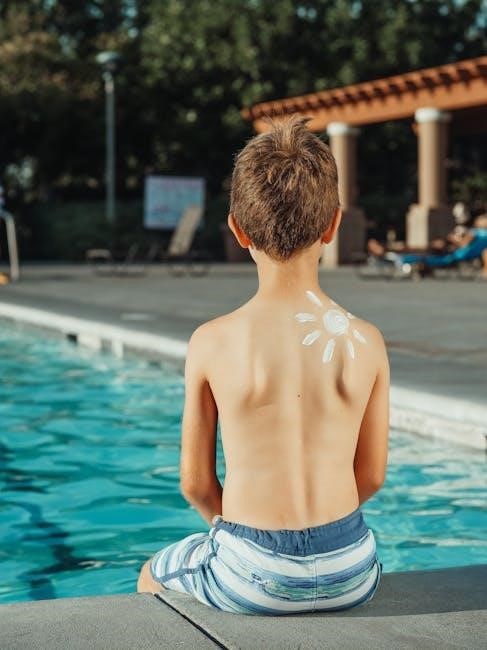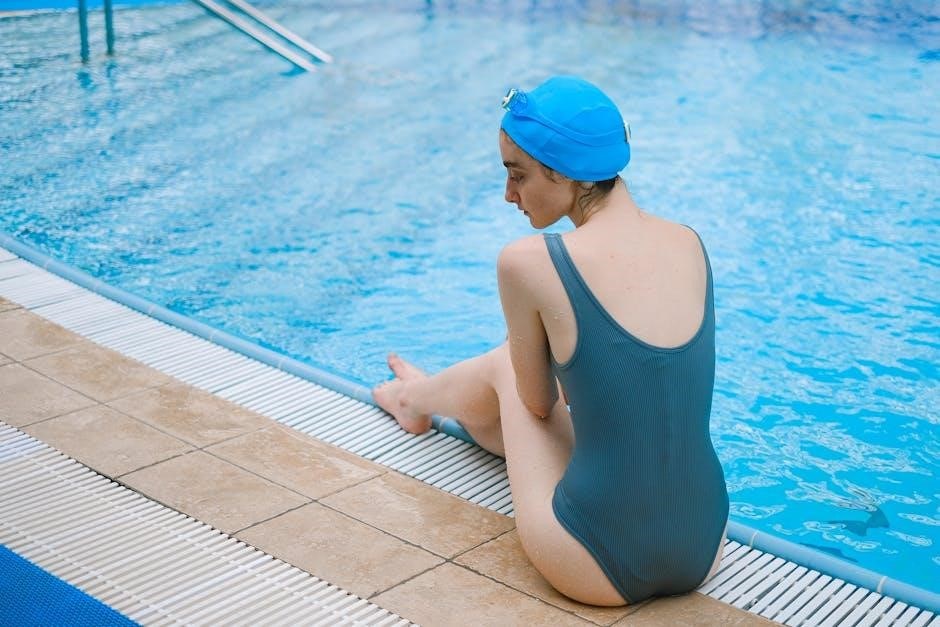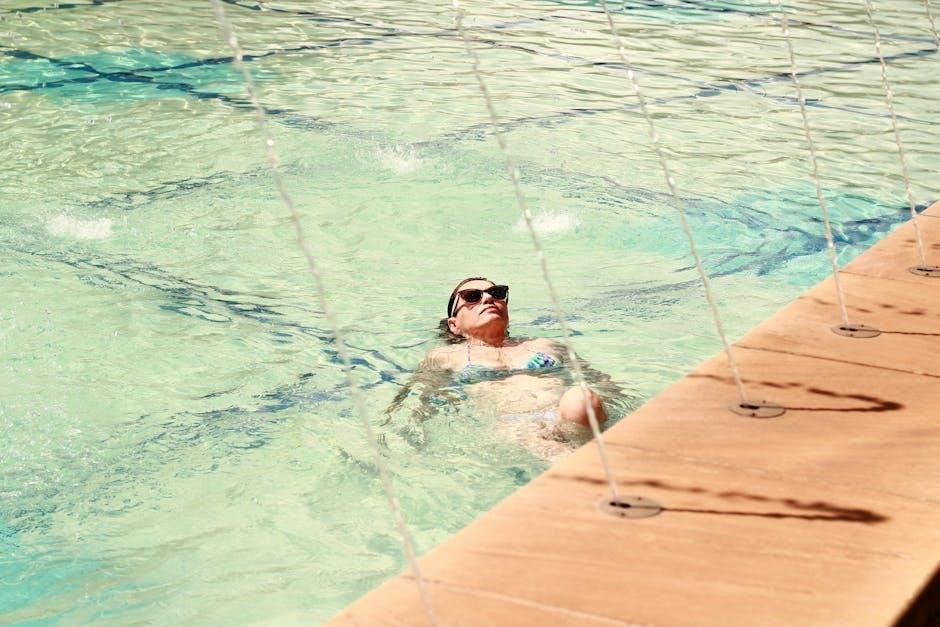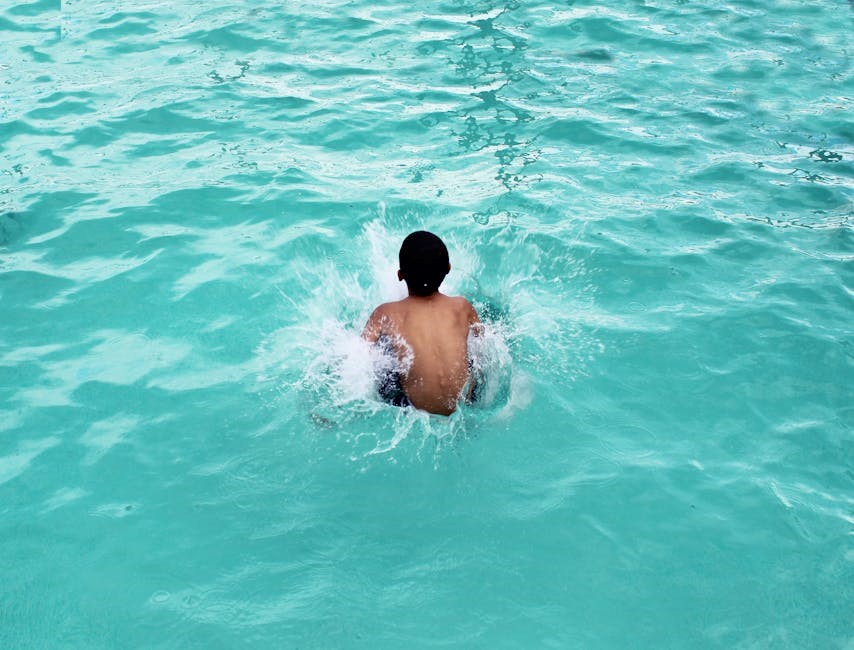Pool exercises offer a low-impact, effective way to alleviate lower back pain. Water’s buoyancy reduces spinal stress, making it ideal for strengthening without strain. Aquatic therapy enhances flexibility and mobility, providing comfort and promoting regular exercise for managing back discomfort effectively.

1.1 Benefits of Aquatic Therapy for Lower Back Pain
Aquatic therapy in a pool offers numerous benefits for individuals suffering from lower back pain. The buoyancy of water reduces spinal stress, allowing for low-impact exercises that strengthen muscles without exacerbating pain. Water supports up to 90% of the body’s weight, making it ideal for those who cannot tolerate land-based workouts. This environment enhances flexibility, improves posture, and strengthens core muscles essential for spinal stability. Additionally, aquatic exercises promote cardiovascular health and endurance, which are crucial for overall well-being. The hydrostatic pressure of water also aids in reducing inflammation and improving circulation, further alleviating discomfort. Many patients find aquatic therapy more comfortable and enjoyable, which increases adherence to exercise routines. Furthermore, the relaxing properties of water can reduce stress and improve mental health, creating a holistic approach to managing lower back pain. Studies suggest that aquatic therapy can significantly reduce pain levels and improve physical function in individuals with chronic lower back pain, making it a highly effective treatment option.
1.2 Essential Pool Equipment for Effective Workouts
Using the right pool equipment can enhance the effectiveness of aquatic exercises for lower back pain. A kickboard is ideal for targeting leg muscles without straining the back, while a pool noodle provides flotation support and assists with balance during stretches. Resistance equipment, such as water dumbbells or pool resistance bands, adds strength training to workouts, helping to build core and back muscles. A step platform placed in the pool is beneficial for step-up exercises, improving strength and mobility. For deep water exercises, a flotation vest ensures safety and freedom of movement. Additionally, pool gloves can increase resistance during arm movements, enhancing the workout’s intensity. Having these tools readily available allows for a diverse and engaging exercise routine tailored to lower back pain relief. They not only make workouts more effective but also provide comfort and confidence in the water, ensuring a safe and enjoyable experience for individuals managing back discomfort.

Pool Exercises for Lower Back Pain
Pool exercises provide a gentle, effective way to strengthen muscles, improve flexibility, and reduce lower back discomfort. These aquatic activities are low-impact, making them ideal for individuals seeking pain relief without exacerbating their condition.

2.1 Pelvic Tilts in the Pool
Pelvic tilts in the pool are a foundational exercise for addressing lower back pain. By targeting the muscles of the pelvis and lower back, this movement helps improve posture, reduce stiffness, and enhance spinal mobility. To perform a pelvic tilt, stand in the pool with your feet shoulder-width apart and hold onto the side of the pool or a pool noodle for balance. Slowly tilt your pelvis backward, flattening your lower back against the water’s resistance, and hold for 5-10 seconds. Release gently and repeat 10-15 times. This exercise strengthens the core and relieves tension in the lower back, making it an excellent starting point for aquatic therapy. The water’s buoyancy reduces strain, allowing for controlled, pain-free movements. Regular practice can lead to improved stability and reduced discomfort in the lower back region. Ensure to maintain a neutral spine and focus on slow, deliberate movements for maximum benefit.

2.2 Knee Lifts and Kicks

Knee lifts and kicks are effective pool exercises for alleviating lower back pain by strengthening the abdominal and hip muscles. To perform a knee lift, stand in the pool with your feet shoulder-width apart and hold onto the side or a pool noodle for stability. Slowly lift one knee toward your chest, keeping your lower back neutral, and hold for 5 seconds before lowering it back down. Repeat on the other side. For kicks, extend one leg behind you while keeping the other foot flat on the pool floor. Gently kick your leg backward, focusing on controlled movements to avoid straining your lower back. Alternate legs and perform 10-15 repetitions on each side.
These exercises improve flexibility and strengthen the muscles that support the spine, reducing discomfort and enhancing mobility. They are low-impact, making them ideal for individuals with chronic lower back pain. Start with slow, small movements and gradually increase your range as comfort allows. Using pool equipment like noodles can provide additional support during the exercises.
2.3 Leg Stretches While Floating

Leg stretches while floating are an excellent way to improve flexibility and reduce tension in the lower back. To perform this exercise, float on your back in the pool, using a pool noodle or vest for support if needed. Bring one leg toward your chest and hold onto your knee with your hand. Gently pull your knee toward your chest until you feel a comfortable stretch in your lower back and hip area. Hold the stretch for 20-30 seconds, then slowly release and repeat on the other side.
For a double leg stretch, float on your back and bring both knees toward your chest simultaneously. Wrap your arms around your knees and gently rock from side to side to enhance the stretch. This movement helps relax the spine and relieve muscle tightness. Perform 10-12 repetitions, taking deep breaths to maximize relaxation.
These stretches are particularly beneficial because the water’s buoyancy reduces pressure on the spine, allowing for a deeper and more comfortable stretch. They improve circulation, reduce muscle spasms, and promote overall relaxation, making them a key component of a pool-based lower back pain relief program. Always move slowly and avoid bouncing to prevent strain.
2.4 Step-Ups in the Pool

Step-ups in the pool are an effective exercise for strengthening the lower back and improving mobility. To perform this exercise, place a small, sturdy step or platform in the pool. Ensure the step is secure and won’t damage the pool floor. Stand in front of the step with your feet shoulder-width apart. Step up onto the platform with one leg, then bring the other leg up to meet it. Step back down slowly, starting with the same leg you used to step up, and repeat on the other side.
Aim for 2 sets of 15 repetitions on each leg. This exercise targets the muscles in your legs and lower back, enhancing strength and stability. It’s particularly useful for individuals who struggle with stair climbing or need to improve functional mobility. Keep your spine neutral and avoid arching your back during the movement to prevent strain. If needed, hold onto the pool edge for balance but focus on maintaining proper form throughout the exercise.
Step-ups in the pool are low-impact and gentle on the joints, making them an ideal choice for managing lower back pain. They improve balance, coordination, and overall lower body strength, which are essential for reducing discomfort and preventing future injuries.
2.5 Cat-Camel Movement in Water
The Cat-Camel movement, adapted for water, is a gentle exercise that promotes spinal flexibility and relaxation. Stand in the pool with the water level at your hips or waist, feet shoulder-width apart, and hands resting on your hips or holding a pool noodle for support. Begin by engaging your core and maintaining a neutral spine.
Slowly arch your back, lifting your chest forward and head slightly upward, like a camel. Hold this position for 5 seconds. Then, gently round your spine, tucking your chin toward your chest and pelvis backward, resembling a cat stretching; Hold for another 5 seconds. Repeat this sequence 10-12 times, moving slowly and smoothly.
This exercise stretches the muscles in your lower back, improves spinal mobility, and enhances posture. The water’s buoyancy reduces strain, making it ideal for individuals with lower back pain. Perform the movement with controlled breathing, exhaling as you arch and inhaling as you round. Avoid forcing your spine beyond a comfortable range to prevent discomfort or injury. The Cat-Camel movement is a soothing way to strengthen and flex your spine in the supportive environment of the pool.

Safety Considerations and Modifications
Always consult a healthcare provider before starting pool exercises. Use flotation devices for balance and support. Avoid deep water if uncomfortable. Modify exercises to avoid exacerbating pain, focusing on gentle movements. Ensure proper technique to prevent injury and maximize benefits.
3.1 Safe Exercise Practices in the Pool
Ensuring safety is paramount when performing pool exercises for lower back pain. Always consult a healthcare provider before starting, especially if pain is severe or chronic. Use pool noodles, kickboards, or flotation devices for balance and support, particularly for beginners. Avoid deep water if it causes discomfort or stress on the spine. Start with gentle movements and gradually increase intensity as comfort allows. Maintain proper posture and engage core muscles to support the lower back during exercises. Avoid twisting or bending excessively, as this can exacerbate pain. If experiencing sharp pain, stop the exercise immediately. Consider working with a physical therapist or instructor experienced in aquatic therapy to guide proper technique. Wear non-slip pool shoes for traction and ensure the pool floor is clear of obstacles. Stay hydrated and take regular breaks to avoid fatigue. By adhering to these practices, individuals can safely benefit from pool exercises while minimizing the risk of injury or discomfort.
3.2 Modifying Exercises Based on Pain Levels
Modifying pool exercises according to individual pain levels is crucial for safe and effective relief from lower back pain. Begin by assessing pain intensity and adjusting exercises to avoid aggravating the condition. For acute pain, focus on gentle movements like pelvic tilts or small knee lifts, which are low-impact and easy on the spine. Avoid deep stretches or twists that may worsen discomfort. Use pool noodles or kickboards for support during exercises, reducing strain on the lower back. If pain increases during an exercise, stop immediately and consult a healthcare professional. For chronic pain, gradually increase the intensity of exercises as tolerance improves. Consider water depth adjustments; shallower water may be less stressful for some movements. Always prioritize proper posture and engage core muscles to stabilize the spine. Listening to your body and making adjustments ensures a safe and beneficial workout experience in the pool.
Pool exercises are a highly effective and gentle approach to managing lower back pain. By leveraging water’s buoyancy, these exercises reduce spinal stress while improving strength, flexibility, and mobility. They are particularly beneficial for individuals who find land-based workouts challenging due to pain or limited mobility. Consistency is key, as regular aquatic therapy can lead to significant improvements in pain levels and overall spinal health. Always consult a healthcare professional to tailor a program suited to your specific needs. With proper guidance and adherence, pool exercises can be a transformative tool in alleviating lower back pain and enhancing long-term well-being.



